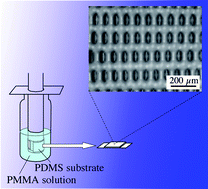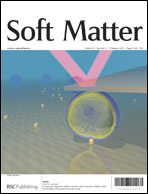Wrinkles with a well-ordered checkerboard pattern, created using dip-coating of poly(methyl methacrylate) on a UV–ozone-treated poly(dimethylsiloxane) substrate†
Abstract
Research on controlling wrinkles of stiff thin films on soft substrates is important for developing low-cost methods for creating micro-structures on a surface. In this paper, dip-coating with an acetonitrile solution of poly(methyl methacrylate) on a UV–ozone-treated poly(dimethylsiloxane) substrate was investigated. After the dip-coating and subsequent drying process, wrinkles were observed on the surface. Although one of the origins of the wrinkling was the swelling of the substrate surface with


 Please wait while we load your content...
Please wait while we load your content...